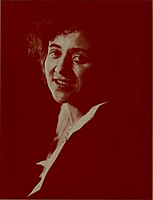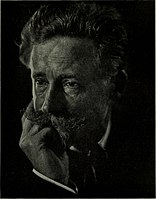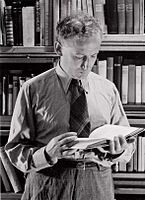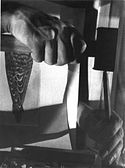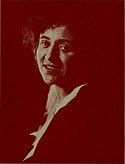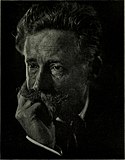Helmar Lerski
| Helmar Lerski | |
|---|---|
 | |
| Narození | 18. února 1871 Štrasburk |
| Úmrtí | 29. září 1956 (ve věku 85 let) Curych |
| Povolání | filmový režisér, fotograf, kameraman, spisovatel a kameraman |
| Některá data mohou pocházet z datové položky. | |

Helmar Lerski (18. ledna 1871, Štrasburk – 19. srpna 1956, Curych) byl fotograf, který stál u zrodu moderní fotografie. Řadí se do světové meziválečné avantgardy jako zástupce německé Nové věcnosti (Neue Sachlichkeit) společně s umělci jako byli Karl Blossfeldt, Albert Renger-Patzsch, August Sander a Walter Peterhans.[1] Tato skupina představovala nový směr, kterým se vydala fotografie v Evropě - tzv. nemanipulovaná fotografie.[2] Jeho dílo je známé v USA, Německu, Izraeli a Švýcarsku. Specializoval se především na portréty a techniku fotografování se zrcadly.
Život
Jeho původní jméno bylo Israel Schmuklerski. Jeho rodina se přestěhovala roku 1876 do Curychu ve Švýcarsku, kde získala 28. srpna 1887 švýcarské občanství. V roce 1888 Lerski emigroval do Spojených států, kde pracoval jako herec. Okolo roku 1910 začal pracovat jako fotograf. Roku 1915 se vrátil zpět do Evropy a pracoval jako kameraman a odborník na speciální efekty na mnoha filmech jako například Metropolis Fritze Langea. Na konci dvacátých let si udělal jméno jako avantgardní portrétní fotograf.
Roku 1932 emigroval se svou druhou ženou do Palestiny, kde pokračoval ve fotografické práci, kameramana a filmového režiséra. 22. března roku 1948 opustil Palestinu a odcestoval zpátky do Zurichu.
Fotografická díla
- Série Köpfe des Alltags: 1928 – 1930, publikováno roku 1931
- Série Metamorphosen: 1936, publikováno roku 1982
Publikace
- 1905: Lebt die Liebe! (s E. F. Ruedebuschem)
- 1930: Die Photographie ist eine große Sache
- 1931: Köpfe des Alltags, Berlin: Verlag Hermann Rockendorf
- 1953: Ich schreibe mit Licht
- 1958: Der Mensch – Mein Bruder (vydal Anneliese Lerski)
- 1982: Verwandlungen durch Licht. Metamorphosis Through Light (vydání Ute Eskildsen)
- Ebner, F.: Metamorphosen des Gesichts. Die "Verwandlungen durch Licht" von Helmar Lerski. Steidl Verlag, Göttingen 2002. ISBN 3-88243-808-8.
- Eskildsen, U. (ed.); Lerski, H.: Verwandlungen durch Licht. Metamorphosis through Light, Freren: Luca, 1982.
- Eskildsen, U.; Horak, J.-C.: Helma Lerski, Lichtbildner. Fotografien und Filme 1910-1947, Folkwang Essen 1982.
Filmografie
|
|
Galerie
- Z cyklu Židovští vojáci (1942-1943)
- Fotografie otisknuta v The American annual of photography (1914)
- Fotografie otisknuta v The American annual of photography (1914)
- Fotografie otisknuta v The American annual of photography (1917)
- Fotograf Walter Zadek
- Fotografie otisknuta v The American annual of photography (1914)
- Mark Lavri
- Avraham Schwadron
Odkazy
Reference
V tomto článku byl použit překlad textu z článku Helmar Lerski na anglické Wikipedii.
Související články
Externí odkazy
 Obrázky, zvuky či videa k tématu Helmar Lerski na Wikimedia Commons
Obrázky, zvuky či videa k tématu Helmar Lerski na Wikimedia Commons - Helmar Lerski: Metamorphose(německy).
- Museum Folkwang, Essen, Německo (německy).
- Article about Metamorphosen, Art Magazin, 2002.
- Some images from Köpfe des Alltags at the George Eastman House.
- Loewy, R.: Adamah - Helmar Lerski's letzter Film (německy).
Média použitá na této stránce
Dr. Abraham Schwadron in Jerusalem, February 1932
赫爾默‧拿斯基,人手(1933年 - 1940年)
Identifier: americanannualof28newy (find matches)
Title: The American annual of photography
Year: 1914 (1910s)
Authors:
Subjects: Photography
Publisher: New York : Tennant and Ward
Contributing Library: Harold B. Lee Library
Digitizing Sponsor: Brigham Young University
View Book Page: Book Viewer
About This Book: Catalog Entry
View All Images: All Images From Book
Click here to view book online to see this illustration in context in a browseable online version of this book.
Text Appearing Before Image:
THE TWINS. EDITH L. WILLIS. If a lantern plate has been rather under exposed a goodaccelerative is Hypo I oz. Water 25 oz. using from 3 to 20 minims of hypo solution to each ounce ofmixed developer. According to Capt. Abney exposure can be reduced one-third by use of the hypo solution, but it is better to avoid itsuse if possible. Ferrous Oxalate has no fogging effects, as it only acts onthe silver that has been affected by the light. The Iron Solu-tion does not keep well and should be kept in small bottleswith waxed corks. The mixed developer also does not keep 88
Text Appearing After Image:
PORTRAIT. Helmar Lerski. well, therefore fresh developer is always desirable. If thewater used contains lime there will be a precipitation whichwill be cleared in the Acid Clearing Bath. The Iron developer is the developer for old stale plates asit will not produce markings or stains. All traces of Pyro must be kept away from the Iron devel-oper or black stains or markings will result from the combina-tion of Pyro and Iron salts. Keep a set of dishes for IronOxalate alone. In mixing Oxalate of Potas. Solution let stand twenty-fourhours and decant off clear liquid for use. An alkali reactionmeans a bad quality of Oxalate and is unfit for use.
Note About Images
Identifier: americanannualof28newy (find matches)
Title: The American annual of photography
Year: 1914 (1910s)
Authors:
Subjects: Photography
Publisher: New York : Tennant and Ward
Contributing Library: Harold B. Lee Library
Digitizing Sponsor: Brigham Young University
View Book Page: Book Viewer
About This Book: Catalog Entry
View All Images: All Images From Book
Click here to view book online to see this illustration in context in a browseable online version of this book.
Text Appearing Before Image:
d under many brands. One chemical Ican vouch for as being the most useful of all the developers,and that is rodinal. It will do anything that any other de-veloper will, if used properly, does not stain the fingers, workswell in any dilution, and makes splendid prints on anypaper. While I am speaking of rodinal, I want to say a word on itsapplication to color photography. A solution of one partrodinal and nine parts water will develop a color plate forfirst or second development with perfect success. I have beenusing this method for the purpose for the last year, and amperfectly satisfied to leave the mixtures of metol, hydroquinoneand ammonia as well as pyro-ammonia to those who like thesmell of ammonia in their laboratory. One new thing I have found with regard to color plates thatmay be of value to others, and that is a method of developingthese plates (Dufay-Autochrome, and the others) with anordinary light, ruby of course being taken for granted. Makeup a solution as follows— 44
Text Appearing After Image:
PORTRAIT. Helmar Lerski. Water lOo cc. io% Potassium Bromide lo cc. Saturated solution of Sodium bisulphate. 2 cc. Bathe your plates, after exposure, in this solution for twominutes. Rinse well in the dark, and you may develop in aruby light as the color sensitiveness is destroyed by this solu-tion. Gradation is not affected and if you are not satisfiedwith working with time and temperature methods, you canobtain excellent results in this way. In speaking of what I consider the most important items ina photographic laboratory, I forgot several things—a Watkinsmeter, and a copy of the Principles and Practise of Photo-graphy, by Alfred Watkins. These two items with a Wat-kins time thermometer should have been mentioned first. In connection with color plates one point must not be for-gotten. If you are photographing dark objects with a colorplate do not forget that your exposure must be increased inthe same ratio as with an ordinary plate, 50 per cent morebeing about right as a general
Note About Images
Identifier: americanannualof28newy (find matches)
Title: The American annual of photography
Year: 1914 (1910s)
Authors:
Subjects: Photography
Publisher: New York : Tennant and Ward
Contributing Library: Harold B. Lee Library
Digitizing Sponsor: Brigham Young University
View Book Page: Book Viewer
About This Book: Catalog Entry
View All Images: All Images From Book
Click here to view book online to see this illustration in context in a browseable online version of this book.
Text Appearing Before Image:
A WINTER MORNING. GEORGE R. BOSWORTH. best should dry in four hours or less, which it will do in awarmed room, especially in the winter time. The sensitizedtissue will keep for several days if protected from the air.The easiest way to do this is to keep it under pressure in aprinting frame in which you have put some black paper toprotect it from the light. The paper is printed about the same length of time that itwould take to print a light solio proof from the same negative,one that will just show the detail wanted in the high lights.Note how long this takes and print the carbon the same time.In printing be sure that the edges of the negative are allcovered by the rebates of the frame, or else by black paper. 298
Text Appearing After Image:
PORTRAIT. Helmar Lerski. This white margin forms a safe edge that protects the printfrom frilling when transferred. While the tissue is printing,or before if desired, some of the transfer paper can be put tosoak in some luke warm water for a few minutes, ready totransfer the picture on to it. To make the transfer place theprinted piece of tissue in a tray of cold water until it flattensout and just begins to curl back with the coated side out, thenput a piece of the wetted transfer paper under it in the sametray, bringing them, together under water so as to exclude air
Note About Images
Portrait of Mark Lavry, an Israeli composer and conductor
Title: Portrait of Helmar Lerski
Work Type: photographs
Date: 1946
Location: Subject: Palestine
Topics: photographers; portraits
Nationality/Culture: Hebrew
Materials/Techniques: Negative (photographic)
Digital image from scan of negative
Note: General: Images acquired from the income of The Rudolph and Sara Wyner Judaica Book Fund in the Harvard College Library (Fund 560357). Copyright: Central Zionist Archives, cza@wzo.org.il Repository: Judaica Division, Widener Library JPCDPZA39398
Record Identifier: olvwork610144Identifier: americanannualof1917newy (find matches)
Title: The American annual of photography
Year: 1917 (1910s)
Authors:
Subjects: Photography
Publisher: New York : Tennant and Ward
Contributing Library: Harold B. Lee Library
Digitizing Sponsor: Brigham Young University
View Book Page: Book Viewer
About This Book: Catalog Entry
View All Images: All Images From Book
Click here to view book online to see this illustration in context in a browseable online version of this book.
Text Appearing Before Image:
'
Text Appearing After Image:
PORTRAIT. HELMAR LERSKI. 241 I also find this an excellent developer for lantern slides, andwhere a plate is inclined to show fog I find it keeps the plateclear. It is a slow working developer, the proper time for goodsnappy prints being about one and a half to two minutes. Forsepias it is excellent.Here is the formula. Stock.Water 40 oz. Dry Sulphite 6 oz. Citric Acid 120 gr. Iron Sulphite i oz. Bromide Potash 4 drachms For use.Water 10 oz. Stock 2^ oz. Amidol 30 grains The developer does not deteriorate very rapidly, hence will go as far as metol-quinol.
Note About Images


